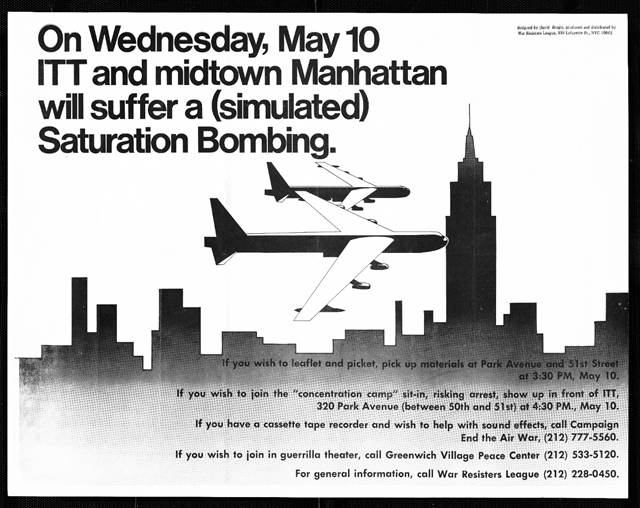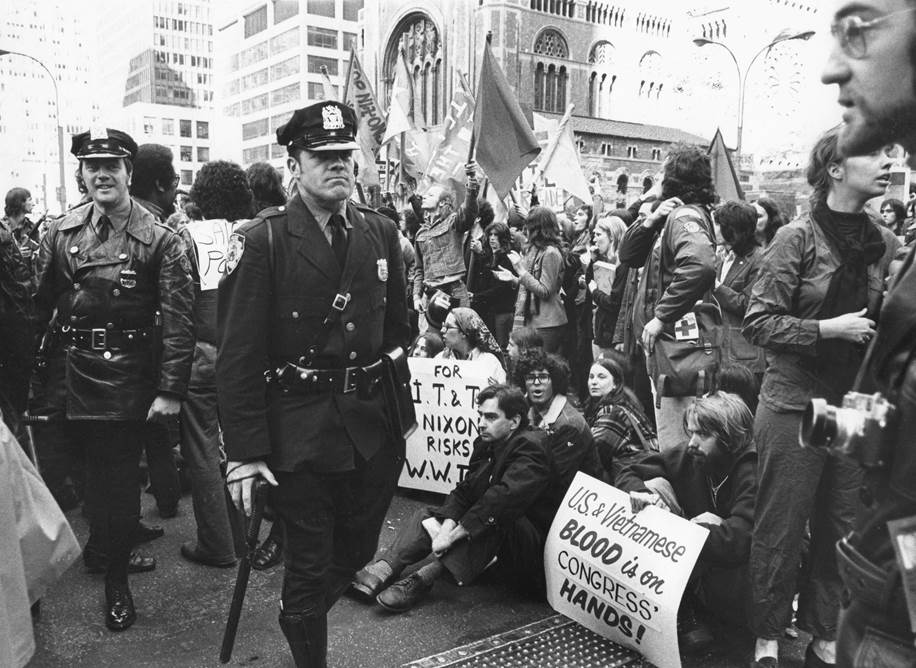
It’s been more than 50 years, but I still remember the ITT demonstration as one of the most creative and dramatic WRL actions of that furiously turbulent time in the antiwar movement.
It was also one of the most fun.
My family and I lived on Staten Island at the time, and I was charged with the “Saturation Bombing” aspect of the action. Others had done the street organizing and rest of the preparation. It was the kind of complicated organizing at which WRL excelled. The Vietnam Veterans Against the War (VVAW) took care of herding the several thousand participants into the “Strategic Hamlet” in front of the smart-bomb contractor ITT headquarters on Park Avenue, across from the very high-end Waldorf Astoria Hotel.
 Image Credit: ITT Demonstration Poster by David Bragin
Image Credit: ITT Demonstration Poster by David Bragin
A few nights before the demonstration, a group of active duty Coast Guardsmen (and a contingent of WRL neighbors and friends) came to our apartment, all of us working well into the night to assemble many hundreds of small parachutes: a handkerchief-sized piece of cloth, threaded straws, ending in a small capsule containing a warning of soon-to-come bomber attacks. These were antiwar sailors whose jobs and futures were at risk if ever identified. A lot of laughter, coffee, beer, and cigarettes.
The parachutes were stuffed into a set of knock-off designer luggage, I'd bought on 14th Street.
On the day of the demonstration, with another WRL member, using a borrowed credit card from a well-to do WRL supporter, we checked into a suite at the Waldorf, where we said we were hosting an anniversary cocktail party. The staff happily delivered our several cases—labeled with various liquor brands but holding the thousands of die-cut leaflets in the shape of smart bombs with descriptions of the role that ITT played in their procurement and the truly horrific effects of their deployment on the population of Vietnam.
Now joined by my good friend, Ed Murphy, a Vietnam veteran active with VVAW and WRL, we made sure the windows facing Park Avenue and the ITT headquarters would open wide enough—we'd brought tools in case they were needed—and waited until the prearranged time.
First, out went the parachutes, floating rather spectacularly out the window and slowly down onto the gathered thousands. Then the leaflets, handful after handful sailing like big snowflakes across Park Avenue, onto the crowd and the street.
Ed and I had agreed we wouldn’t hang around the suite, luxurious as it was, and took the stairs up a few flights. We waited few minutes and took the elevator back down the lobby. As we were strolling out, the police were running in.
 (Photo Credit: Diana Davies)
(Photo Credit: Diana Davies)
Outside, we joined the demonstration, which was in full swing. As I said, it was a daunting organizing job, a tribute to movement cooperation, and for Ed and me, lots of fun.
One of the interesting sidelights of the action: a couple of apparently unaffiliated cabdrivers parked their cabs in the intersection at the end of the block on Park Avenue, removed the distributor caps and walked away.
As far as I know, the ITT action was perhaps the best example of a unified movement—pacifist and veteran—calculated to make a dramatic statement: the need for peace. We demonstrated for an end to American involvement in the slaughter of Vietnamese civilians and US personnel. Public opinion was turning and I like to think we who were active in the Peace movement were responsible.
When Ed and I talked about this blog, he suggested I note that had we to do it over again, we might be more environmentally conscious and create less litter and trash. Maybe so.
—Van Zwisohn
Van was active with WRL from the late 60s and throughout the 80s. Previously he did volunteer voter registration work in the South in mid 60s. With WRL, he served as volunteer, organizer, and member of the National Executive Committee. In the late 70s he was the executive director of the AJ Muste Memorial Institute. Subsequently, Van worked as an attorney with the Saratoga County Public Defender's office until his retirement in 2013.





